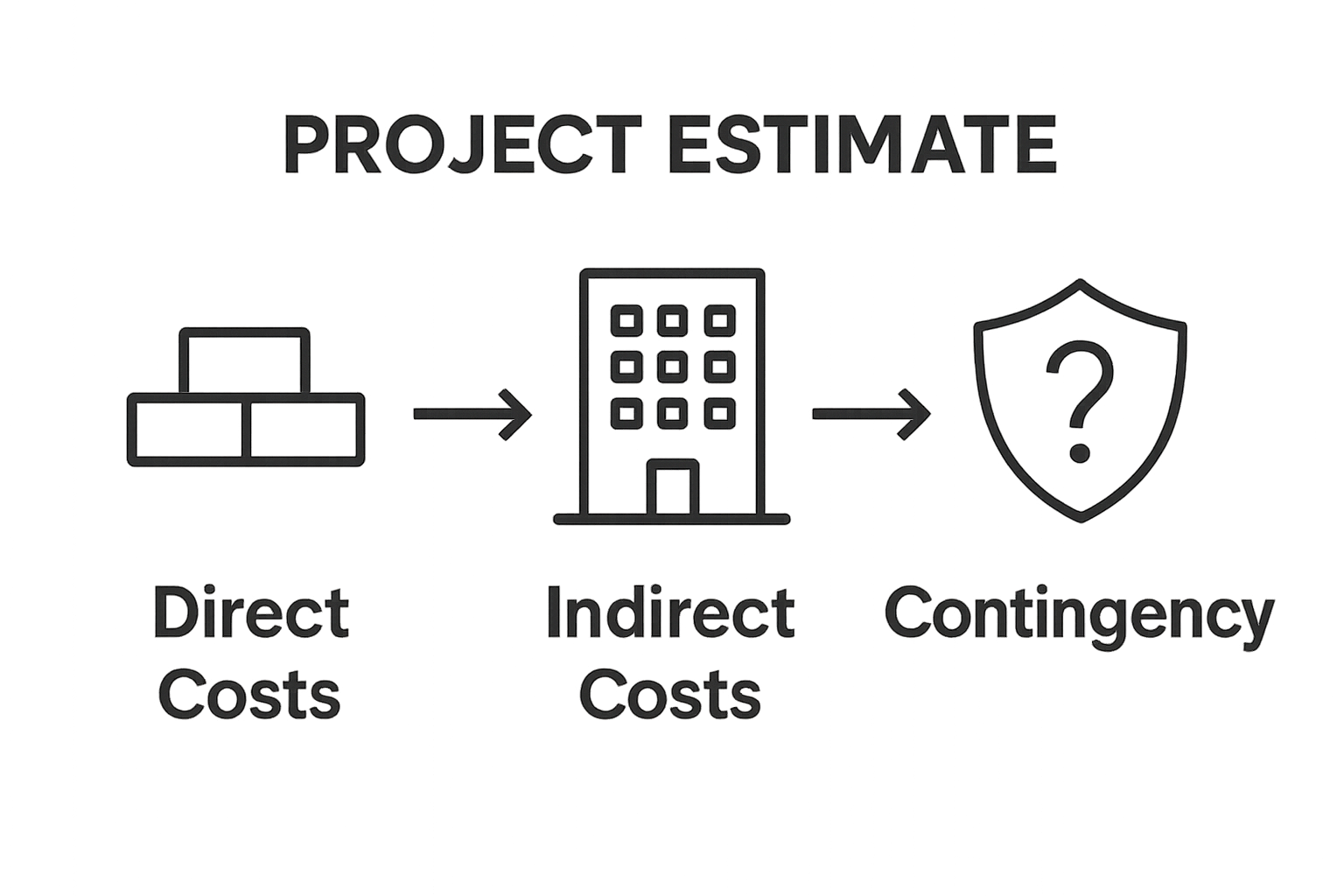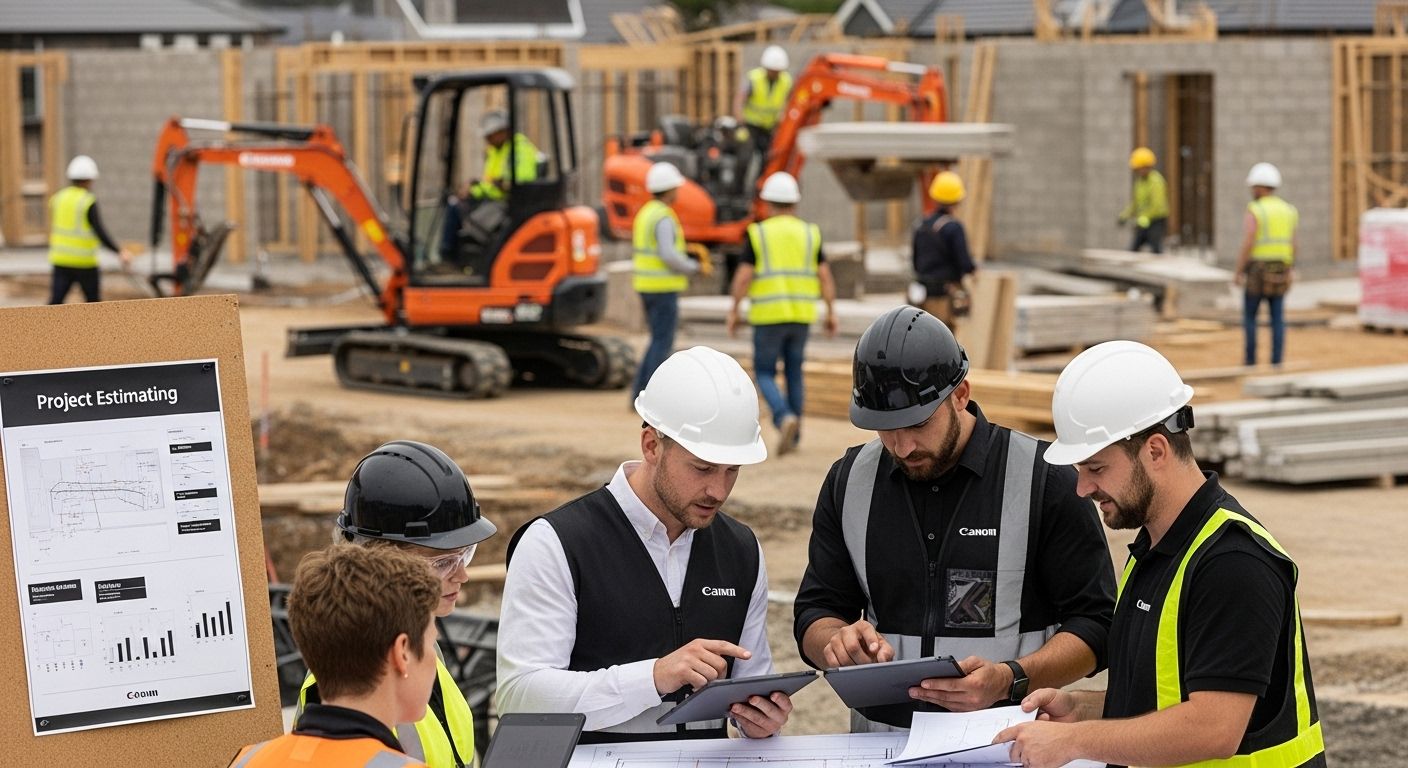Every construction project starts with a vision and a budget, but only those with a reliable estimating workflow stand a real chance of success. Some might expect estimating to be little more than guesswork with spreadsheets and rough figures. In reality, a robust building project estimating workflow can slash the risk of budget failure by systematically transforming raw specifications into a detailed financial blueprint, and research shows that project complexity has a direct impact on estimation accuracy. The real story is how this methodical process creates clarity and control long before the first brick is laid.
Table of Contents
- What Is Building Project Estimating Workflow?
- Why Is Accurate Estimating Important In Construction?
- How Does The Estimating Workflow Function?
- Key Concepts In Building Project Estimating
- Real-World Applications And Examples Of Estimating Workflows
Quick Summary
| Takeaway | Explanation |
|---|---|
| Accurate estimating is crucial for project success. | Proper cost estimation influences financial sustainability and operational efficiency, minimising risks of budget overruns. |
| Estimating workflow consists of multiple interconnected stages. | The process includes gathering specs, conducting assessments, and calculating costs to create precise financial models. |
| Effective risk management relies on precise estimating. | Accurate predictions help anticipate financial challenges and identify cost-saving opportunities early in the project. |
| Technological integration enhances estimating accuracy. | Advanced tools and techniques, like BIM and predictive modelling, improve cost projections and responsiveness to project variables. |
| Granular cost models enable better resource allocation. | Detailed breakdowns of costs help in negotiating with suppliers and optimizing resource distribution across projects. |
What is Building Project Estimating Workflow?
A building project estimating workflow represents the comprehensive systematic process through which construction professionals analyse, calculate, and predict the total financial requirements and resource allocation for a specific building project. This intricate workflow transforms raw project specifications into a detailed financial blueprint that enables precise budgeting, strategic planning, and effective project management.
Core Components of Estimating Workflow
The building project estimating workflow encompasses several critical interconnected stages designed to provide accurate cost predictions. According to the UK Government’s Infrastructure and Projects Authority, these components typically include:
- Gathering comprehensive project specifications and technical drawings
- Conducting thorough site assessments and evaluating potential constraints
- Performing detailed material quantity measurements
- Calculating labour and equipment costs
- Developing precise cost projections with contingency allowances
Professional estimators approach this workflow as a methodical process of converting complex architectural plans and engineering specifications into quantifiable financial metrics.
The following table presents the core components of the building project estimating workflow alongside concise explanations, aiding quick reference and comprehension of their respective roles.
| Component | Explanation |
|---|---|
| Project Specifications & Drawings | Gathering detailed architectural and engineering documents that define project requirements. |
| Site Assessment & Constraints Evaluation | Reviewing the construction site to identify physical or logistical challenges affecting costs. |
| Material Quantity Measurement | Calculating precise amounts of materials needed for project completion. |
| Labour & Equipment Cost Calculation | Assessing workforce requirements and machinery costs related to the project. |
| Cost Projections & Contingency Allowances | Developing financial models that include predicted costs and risk buffers for uncertainties. |
Strategic Importance of Accurate Estimating
A robust building project estimating workflow serves multiple critical functions within construction management. Learn more about our comprehensive cost estimation approach to understand how precision in initial financial planning can dramatically impact project success.
The workflow acts as a crucial risk management tool, enabling project managers to anticipate potential financial challenges, allocate resources effectively, and maintain budgetary control. By systematically breaking down project requirements into granular cost components, estimators can identify potential inefficiencies, negotiate more effectively with suppliers, and provide transparent financial projections to project shareholders.
Ultimately, a well-executed building project estimating workflow transforms complex construction challenges into clear, actionable financial strategies that support successful project delivery.
Why is Accurate Estimating Important in Construction?
Accurate estimating represents the foundational cornerstone of successful construction project management, directly influencing financial sustainability, operational efficiency, and overall project viability. Construction professionals understand that precise cost prediction is not merely a mathematical exercise but a strategic imperative that can determine the difference between project success and potential financial catastrophe.
Financial Risk Mitigation
Accurate estimating serves as a critical risk management mechanism within construction projects. According to research from the University of Reading, project complexity significantly impacts estimation accuracy, underscoring the need for meticulous financial forecasting. The primary financial risks that precise estimating helps mitigate include:
- Preventing budget overruns that could jeopardise project completion
- Ensuring realistic financial commitments to clients and shareholders
- Identifying potential cost-saving opportunities during early planning stages
- Maintaining competitive pricing without compromising project quality
Professional estimators deploy sophisticated analytical techniques to transform complex architectural specifications into precise financial projections, creating a robust framework for financial planning and resource allocation.
Strategic Project Planning
Explore our comprehensive construction estimating strategies to understand how accurate estimation drives strategic decision making. Precise estimating enables construction managers to develop comprehensive project roadmaps that align financial expectations with realistic operational capabilities.
Beyond immediate financial considerations, accurate estimating influences broader project dynamics. It provides critical insights into resource requirements, potential bottlenecks, and potential areas of efficiency improvement. By developing granular cost models, construction professionals can negotiate more effectively with suppliers, allocate resources strategically, and create transparent financial communication channels with all project shareholders.
Ultimately, accurate construction project estimating transforms potential financial uncertainty into a structured, predictable pathway towards successful project delivery, minimising risks and maximising operational effectiveness.
How Does the Estimating Workflow Function?
The building project estimating workflow operates as a sophisticated, interconnected system of analytical processes designed to transform complex architectural specifications into precise financial projections. This intricate methodology requires strategic collaboration between various construction professionals to ensure comprehensive and accurate cost estimation.
Initial Project Assessment and Documentation
According to research from the University of Northumbria, the initial stages of the estimating workflow are critical for establishing a robust foundation for financial planning. The process typically begins with comprehensive project documentation analysis, which includes:
- Detailed review of architectural and engineering drawings
- Examination of site-specific conditions and potential constraints
- Identification of specific project requirements and technical specifications
- Assessment of material and labour availability in the project location
Professional estimators meticulously analyse these documents to develop an initial understanding of the project’s scope, complexity, and potential financial implications. This initial assessment serves as the foundational framework for subsequent detailed cost calculations.
Quantification and Cost Modelling
Discover our advanced estimating techniques to understand the intricate process of transforming project specifications into precise financial models. The quantification stage involves systematically breaking down project requirements into measurable components, enabling accurate cost prediction.
Estimators deploy sophisticated analytical techniques to calculate material quantities, labour requirements, and associated costs. This process involves using advanced computational tools, historical cost data, and industry-specific pricing databases to generate comprehensive cost models. By integrating multiple data sources and leveraging technological innovations, professionals can develop highly precise financial projections that account for potential variables and market fluctuations.
Ultimately, the estimating workflow functions as a dynamic, iterative process that continuously refines cost predictions through meticulous analysis, technological integration, and expert professional judgment.
Key Concepts in Building Project Estimating
Building project estimating encompasses a complex array of technical and financial principles that transform architectural vision into pragmatic financial planning. Professional estimators must navigate intricate methodological frameworks that balance precision, risk management, and strategic financial forecasting.
Fundamental Estimation Parameters
Research from the National Construction Estimating Institute highlights several critical parameters that form the foundation of accurate project cost estimation. These fundamental concepts include:
- Direct cost calculation for materials and labour
- Indirect cost allocation including overhead and administrative expenses
- Risk contingency provisions for potential unforeseen circumstances
- Detailed quantitative measurements of project specifications
- Market-driven pricing adjustments reflecting current economic conditions
Professional estimators understand that each parameter represents an interconnected component of a comprehensive financial model. The precision with which these parameters are evaluated directly influences the overall accuracy and reliability of the project’s financial projection.
The following table outlines fundamental estimation parameters within building project estimating, clarifying how each contributes to the accuracy and reliability of the overall cost projection.
| Estimation Parameter | Description |
|---|---|
| Direct Cost Calculation | Measure of costs attributed directly to materials and labour for the project. |
| Indirect Cost Allocation | Assignment of overhead, administrative, and other non-direct expenses. |
| Risk Contingency Provision | Financial allowance set aside for unforeseen circumstances or uncertainties. |
| Quantitative Measurement | Detailed analysis of quantities specified within project documentation. |
| Market-Driven Pricing Adjustments | Adjustments based on current economic conditions and local market factors. |

Technological Integration and Analytical Techniques
Explore our advanced estimating methodologies to understand how modern technology transforms traditional estimation approaches. Contemporary building project estimating leverages sophisticated computational tools and analytical techniques that transcend traditional manual calculation methods.
Advanced estimating practices now incorporate digital technologies such as Building Information Modelling (BIM), machine learning algorithms, and comprehensive databases that enable real-time cost tracking and predictive financial modelling. These technological innovations allow estimators to develop increasingly nuanced and adaptive cost projections that can quickly respond to complex project variables.
Ultimately, key concepts in building project estimating represent a sophisticated intersection of technical knowledge, financial acumen, and technological innovation, enabling construction professionals to transform architectural designs into financially viable and strategically planned projects.
Real-World Applications and Examples of Estimating Workflows
Building project estimating workflows transcend theoretical frameworks, manifesting as critical operational strategies across diverse construction environments. These workflows represent dynamic methodological approaches that adapt to complex project requirements, integrating sophisticated analytical techniques with practical financial management strategies.
Residential Construction Project Scenarios
According to research from Nottingham Trent University, residential construction projects demonstrate the nuanced application of estimating workflows. These scenarios typically involve:
- Precise calculation of material quantities for individual housing units
- Comprehensive labour cost projections accounting for skilled workforce requirements
- Detailed site-specific constraint assessments
- Adaptive pricing models reflecting localised market conditions
- Integrated risk management strategies for potential budget variations
Professional estimators leverage these detailed analytical frameworks to transform architectural designs into financially viable residential development projects, ensuring transparency and predictability throughout the construction lifecycle.

Commercial and Infrastructure Project Implementation
Discover advanced estimating approaches for complex projects to understand how workflow methodologies scale across different project complexities. Commercial and infrastructure projects represent particularly challenging domains where estimating workflows demonstrate remarkable adaptability.
In large-scale infrastructure developments, such as transportation networks or public facilities, estimating workflows integrate multiple layers of financial complexity. These implementations require sophisticated computational models that can simultaneously track material costs, labour expenses, regulatory compliance requirements, and potential environmental impact mitigation strategies. By developing comprehensive cost projection systems, construction professionals can navigate intricate financial landscapes with unprecedented precision and strategic insight.
Ultimately, real-world applications of estimating workflows showcase the transformative potential of systematic, technology-enabled financial planning in construction project management.
Take the Guesswork Out of Your Building Project Estimates
If you struggle with uncertainty in construction project costs or worry about missing hidden expenses, you are not alone. As discussed in this article, achieving accuracy in your estimating workflow is crucial to avoiding budget overruns and steering clear of avoidable setbacks. From translating technical drawings into real costs to factoring in detailed site conditions and resource allocations, these challenges can feel overwhelming without dedicated expertise.
At My Project Estimating, we bridge the gap between complex cost prediction and straightforward financial clarity. Our tailored solutions combine technical skill with up-to-date market knowledge, offering services rooted in the core concepts you have just read about. Browse our Cost Estimating Archives to see how we support contractors, developers, and architects with every stage of the estimating workflow. Ready to work with specialists who put accuracy, transparency, and client confidence first? Visit My Project Estimating today and take control of your next building project. Now is the time to make every estimate count.
Frequently Asked Questions
What is a building project estimating workflow?
A building project estimating workflow is a systematic process used by construction professionals to analyse, calculate, and predict the overall financial requirements and resource allocation for a building project, transforming raw specifications into a detailed financial blueprint.
Why is accurate estimating important in construction?
Accurate estimating is essential for financial sustainability, operational efficiency, and overall project viability. It helps mitigate financial risks, avoid budget overruns, and supports informed strategic planning to enhance project success.
What are the key components of the estimating workflow?
The key components typically include gathering project specifications, conducting site assessments, performing material quantity measurements, calculating labour and equipment costs, and developing detailed cost projections with contingency allowances.
How does the estimating workflow function in a construction project?
The estimating workflow functions as an interconnected system of analytical processes that transforms architectural specifications into precise financial projections, requiring collaboration between various professionals to ensure comprehensive and accurate estimates.


